![]()
![]()
![]()
Use LEFT and RIGHT arrow keys to navigate between flashcards;
Use UP and DOWN arrow keys to flip the card;
H to show hint;
A reads text to speech;
61 Cards in this Set
- Front
- Back
- 3rd side (hint)
|
List out metabolic processes that occur in the mitochondria
|
beta oxidation of FA, ketogenesis, TCA cycle, parts of the urea cycle (CPS I and OTC) and pyruvate carboxylation; all reactions of pentose phosphate pathway
|
|
|
|
Catecholamines and glucagon stimulates what metabolic pathway?
|
Glycogenolysis
|
|
|
|
Glycogenolysis is stimulated with what molecules binding to cell receptors?
|
Catecholamines (NE and Epi) and glucagon
|
|
|
|
Which molecule increases gluconeogenesis in the liver when it binds to cell receptors?
|
Cortisol
|
|
|
|
How do you distinguish initial presentation of fructose intolerance vs. classic galactosemia
|
Both present similarly with vomiting, hepatomegaly, and jaundice.
However, classic galactosemia occurs soon after breastfeeding is initiated (galactose in breast milk), whereas fructose intolerance occurs soon after introduction of fructose into the diet (after weening) |
|
|
|
Sickle cell dz has what kind of inheritance pattern
|
AR
|
|
|
|
How can one identify sickle cell trait on lab analysis?
|
Electrophoresis - HbS moves slowly compared to normal Hb, due to loss of the negatively charged amino acid glutamate that is switched to valine
|
|
|
|
Write out the G-protein dependent phopholipase C pathway.
|
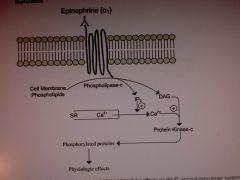
Refer to image
|
|
|
|
Branched-chain alpha ketoacid DH, pyruvate DH, and alpha-KG DH all require which cofactors?
|
Thiamine pyrophosphate, Lipoic Acid, Coenzyme A, FAD, NAD
"Tender Loving Care For Nancy" |
|
|
|
Maple Syrup Urine Dz Clinical presentation and pathogenesis
|
Blocked degradation of branched amino acids (Ile, Leu, Val - I love Vermont maple syrup from branched maple trees) due to decreased alpha-ketoacid DH.
Sx: severe CNS defects, MR, death |
|
|
|
What is pyridoxine involved in?
What is it used to treat? |
Pyridoxine (Vit B6) as pyridoxal phosphate is involved in the transamination and decarboxylation steps in AA metabolism as well as heme and NT synthesis.
Pyridoxine supplementaiton is used in the tx of sideroblastic anemia and hyperhomocysteinemia. |
|
|
|
A single AA residue replacement in the Hb beta subunit results in poor ionic interaction with 2,3-bisphosphoglycerate.
The resultant Hb has the properties of which type of Hb? |
HbF
Normally, 2,3-DPG forms ionic bonds with the two beta subunits of HbA in the tissues after Hb has been deoxygenated. Fetal Hb binds O2 with a higher affinity due to its inability to interact with 2,3-DPG. Ultimately, the fetal Hb must be able to extract O2 from maternal Hb in the placenta. |
|
|
|
Describe regulation of the lac operon.
|
1) negatively by binding of the repressor protein to the operator locus
2) positively by cAMP-CAP binding upstream from the promoter region. Repressor proteins are constitutively expressed. Culture of E.coli in latose containing media causes a conformational change in the repressor protein, preventing its attachment to the operator region and increasing transcription of the lac operon structural genes. |
|
|
|
Hartnup dz: discuss pathophys and tx
|
defective neutral amino acid transporter on renal and intestinal epithelial cells
Causes tryptophan excretion in urine and decreased absorption in gut (loose stools) can be caused by vitamin b3 (niacin): Hartnup dz can result in niacin deficiency due to an excess loss of dietary tryptophan (remember that niacin is synthesized from tryptophan and that tryptophan is an essential AA. PELLAGRA! - |
|
|
|
Discuss the mechanism of streptomycin
|
Streptomycin inhibits the initiation of protein synthesis by binding to and distorting the structure of the prokaryotic 30S ribosomal subunit.
|
|
|
|
Discuss mechanism of tetracycline.
|
Interferes with binding of aminoacty-tRNA to the A site
|
|
|
|
How do you distinguish clinically btw OTC and CPS I deficiency?
|
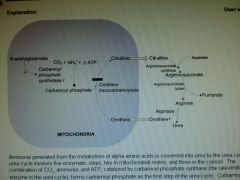
Both OTC and CPS I deficiency result in increased ammonia levels. However, increased urine orotic excretion is only observed in OTC deficiency (accumulated carbamoyl phosphate is converted into orotic acid)
Q: What regulates CPS I? |
N-acetylglutamate
|
|
|
How are very long chain FA or FA with branch points at odd-numbered carbons oxidized?
What cellular structure is required for oxidation of these FA? Sx? |
Special form of beta oxidation (for very long chain fatty acids) or Alpha Oxidation (branched chain fatty acids such as phytanic acid)!
Peroxisomes are required to break these down. Dz results in neurologic deficits from improper CNS myelination. |
|
|
|
14 yo female evaluated for neuro sx. at 10 percentile for weight and height. Lab reveals megaloblastic anemia with very high urine orotic acid secretion.
What supplementation would benefit this pt? |
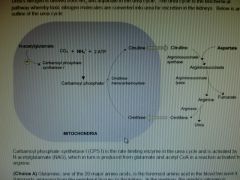
Uridine
A pt with orotic aciduria (impaired e novo pyrimidine synthesis) will present with hypochromic megaloblastic anemia, neurologic abnormalities, growth retardation and excretion of orotic acid int he urine. Uridine supplementation improves sx by inhibiting carbamoyl synthetase II |
|
|
|
When prescribing isoniazid, you should also prescribe what?
|
Pyridoxine (Vit B6) supplementation
|
|
|
|
Ascorbic acid fxn
|
required for hydroxylation of proline and lysine residues in collagen synthesis; therefore, plays an important role in connective tissue maintenance and wound healing
|
|
|
|
Niacin is an essential component of what coenzymes?
What AA is it synthesized from? Deficiency results in what condition? |
NAD and NADP.
Tryptophan Pellagra: dermatitis, diarrhea, and dementia (3Ds of Vit B3) |
|
|
|
Describe the sx of homocystinuria.
What supplementation may help with this condition? |
Cystathionine synthetase deficiency
Thromboembolic episodes involving both large and small vessles, especially those o the brain; Marfan syndrome like sx (elongated limbs, arachnodactyly, and scoliosis) about 50% of pts respond dramatically to pyridoxine (Vit B6) supplementation (only tx at this time) |
|
|
|
homeless guy with increased fatigability and exertional dyspnea. Significant lower extremity edema and decreased sensation over ankles and feet. Cardiac dilation and increased CO noted.
What nutrient deficiency? |
Thiamine (Vit B1) deficiency - wet beriberi
Ber1Ber1 |
|
|
|
Polyneuritis and symmetric muscle wasting. What nutrient deficiency?
|
Vit B1 - Wet Ber1Ber1
|
|
|
|
Hemorrhages, bleeding into joint spaces, gingival swelling, weakened immune system
|
Vit C deficiency - scurvy
|
|
|
|
Vit C deficiency - scurvy sx
|
Hemorrhages, bleeding into joint spaces, gingival swelling, weakened immune system
|
|
|
|
Pernicious anemia sx
|
classically in mentally slow woman of northern European descent who is "lemon-colored" (anemic and icteric), has a smooth, shiny tongue indicative of atrophic glossitis, and demonstrates a shuffling broad-based gait.
|
|
|
|
Increased HbF, HBA2, and target cells
|
beta thalessemia
Q: What process is defective in thalassemias? |
mRNA processing
|
|
|
Intermediate source of nitrogen for urea in the urea cycle?
|
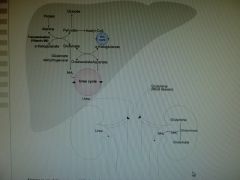
Aspartate
(nitrogen atoms are also derived from NH3) |
|
|
|
Which AA transports ammonia from the peripheral tissues to the kidney?
|
Glutamine
in the nephron, the amide's nitrogen is hydrolyzed by the enzyme glutaminase, thereby producing glutamate and free ammonium ion. The ammonium ion can then be excreted int he urine. |
|
|
|
Three prominent features of Marfans
|
Extremities: long thin extremities, loose joints, and long fingers (arachnodactyly)
Ocular abnormalities such as dislocation of lens Cardiovascular abnormalities including ascending aortic aneurysm, aortic dissection, and mitral valve prolapse. |
|
|
|
Which cells cannot use ketone bodies for energy?
|
Erythrocytes and other cells lacking mitochondria. Also hepatocytes bc they lack a required enzyme
|
|
|
|
Alanine is given to volunteers. Before conversion to glucose, the alanine transfers its amino group to _____.
|
alpha-KG
Amino groups are released during the metabolism of AA. These amino groups are primarily transferred to alpha-KG to form glutamate, the primary carrier of ammonia from the liver. Glutamate is later excreted by the renal nephron as either free ion or urea. |
|
|
|
Homeobox (Hox) genes code for what protein type?
|
Transcription regulators which alter the expression of genes involved in morphogenesis - proper formation and placement of tissues, organs and structural elements of the body.
|
|
|
|
Defective ubiquination can result in what diseases?
|
Alzheimer's and Parkinson's - failure of system to properly degrade abnormal proteins causes protein misfolding, aggregation, and eventual obstruction of intracellular molecular traffic, leading to cell death.
|
|
|
|
Explain why wrinkles appear with age.
|
Decreased collagen fibril production
|
|
|
|
urine turns black upon standing
|
alkaptonuria or acute intermittent porphyria
|
|
|
|
How does high glucose infusion protect against acute intermittent porphyria?
|
Glucose loading decreases porphyrin synthesis by repressing ALA synthase activity, thus alleviating the abdominal pain and neuropsychiatric manifestations of acute intermittent porphyria (AIP)
|
|
|
|
Describe the pathway for dietary fructose to participate in glycogen synthesis
|
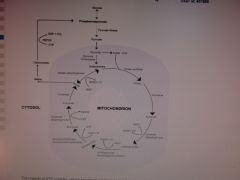
see image
|
|
|
|
Vit A overuse sx
|
intracranial hypertension, skin changes and hepatosplenomegaly
|
|
|
|
Radiation (chemotherapy) induces what type of DNA damage?
Alkylating agents? UV radiation? |
DNA double strand fractures and the formation of oxygen free radicals
DNA cross-linking pyrimidine-pyrimidine dimers (thymine dimers) |
|
|
|
Describe hemoglobin composition of fetal hemoglobin and adult hemoglobin.
|
HbF dominates in newborns. It consists of two alpha and two gamma protein subunits, has a high affinity for O2 and is produced during the final seven months of gestation.
Switching to HbA (alpha 2 beta 2) occurs during the first six months of life |
|
|
|
A point mutation is found in the beta globin gene, which results in the replacement of G by C in the beta globin mRNA molecule three bases upstream from the AUG codon.
What process is most likely impaired? |
Initiation of translocation (mRNA binding to ribosomes)
This is the Kozak sequence which plays a role in the initiation of translation. A mutation three bases upstream from the start codon (AUG) in this sequence is associated with thalassemia intermedia. Q: Thalassemia intermedia results in what kind of anemia? |
hypochromic, microcytic anemia
|
|
|
Why are patients with thalassemias asymptomatic at birth?
|
Due to the presence of gamma globins in HbF. Switching to HbA production and the cessation of gamma globin synthesis precipitates the sx of thalassemia
|
|
|
|
See image
|
E
|
|
|
|
How do you treat cyanide poisoning?
How does cyanide poisoning present? |
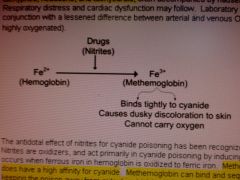
Nitrites (ie amyl nitrite) --> indues formation of methemoglobin, which has a high affinity for CN and keeps it from the blood and away from mitochondrial enzymes
- rapidly developing cutaneous flushing, tachypnea, H/A, tachycardia, often accompanied by N/V, confusion, and weakness. Respiratory distress and cardiac dysfunction may follow (mimic serotonin syndrome??) |
|
|
|
Pt with Ehlers-Danlos. Histologic evaluation with EM reveals collagen fibrils that are abnormally thin and irregular. Biochemical evaluation reveals abundant terminal disulfide bonds.
Which stage of collagen synthesis is most likely impaired in this patient? |
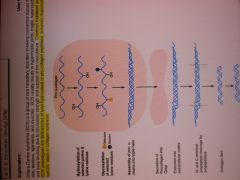
Extracellular Cleavage
|
|
|
|
Pt develops a large bruise over the chest after MVA. Several days later, the bruise has a greenish color.
Which enzyme has created this color? |
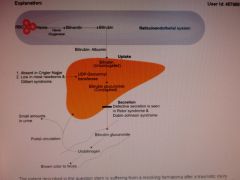
Heme oxygenase
|
|
|
|
Low activity of G6PD (resulting in hemolysis).
Deficiency of what RBC enzyme has the same pathophysiology as this condition? |
Glutathione reductase
- G6PD deficiency is a defect in the HMP shunt that impairs glutathione reduction due to failure to produce NADPH. Glutathione reductase deficiency causes a similar clinical picture and is pathophysiologically similar to G6PD deficiency. |
|
|
|
Functions of transketolase and transaldolase
|
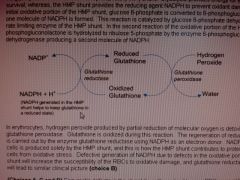
catalyze the non-oxidative reactions of the HMP shunt and are primarily designed to generate ribose 5-phosphate from fructose 6-phosphate and glyceraldehyde 3-phosphate or the reverse.
|
|
|
|
Which vitamin supplementation can benefit a measles patient?
|
Vitamin A
|
|
|
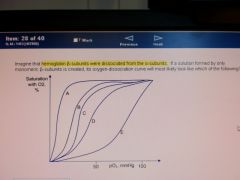
see image
|

A
Sigmoidal shape of hemoglobin oxygen-dissociation curve results from the tetrameric nature of hemoglobin and how after binding to one molecule,t he affinity of other heme molecules for oxygen increases (heme-heme interaction) On the other hand, myoglobin has only one heme molecule, so its interaction with O2 is simpler. Myoglobin has a much higher affinity for O2 and does not experience heme-heme interactions --> therefore, its O2 dissociation curve is hyperbolic. |
|
|
|
List causes of splenic hypertrophy
|
1) Intracellular substance accumulation (as in glycogen storage dz)
2) Passive congestion - portal hypertension, venous thrombosis and CHF 3) Inflammatory infiltration - spleen plays an important role in fighting infectious pathogens and thus, many infections lead to enlargement due to proliferation of lymphoid tissue. 4) Work hypertrophy - hemolytic anemia - spleen must work harder to remove deformed erythrocytes from circulation 5) Neoplasm - disorders such as leukemia and lymphoma due to neoplastic proliferation of lymphoid tissue within the spleen |
|
|
|
Lactic acidosis may be explained by low activity of what enzyme? High activity of what enzyme?
|
Low activity of pyruvate DH or high activity of Lactate DH
|
|
|
|
What is the principal stabilizing force for secondary structure of proteins?
tertiary structure? |
- H bonds are the principal stabilizing force for secondary structure.
- ionic bonds, hydrophobic interactions, H bonds, and disulfide bonds are all implicated in tertiary structure. |
|
|
|
An infant has impaired transport of ornithine from the cytosol to the mitochondria. Restriction of what type of energy source can improve this pt's condition (fatty acids, protein, cholesterol, monosaccharides, disaccharides, purines)?
|
Protein - Ornithine transport into mitochondria is essential for urea formation, as ornithine is needed to combine with carbamoyl phosphate within the mitochondria to form citrulline in the second step of the urea cycle.
|
|
|
|
End product of sucrose metabolism is ______.
|
Fructose
Lens has significant levels of sorbitol DH, which become overwhelmed in the setting of hypoglycemia. Other tissues, such as the retina, renal papilla, and Schwann cells, have much less sorbitol DH activity. |
|
|
|
Know the signaling pathways of endocrine hormones:
cAMP, cGMP, IP3, Steroid (cytosolic and nuclear), Intrinsic tyrosine (MAP kinase), receptor associated tyrosine kinase (JAK/STAT pathway) |
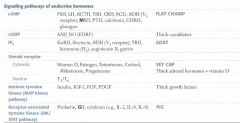
see image
|
|
|
|
Explain the mechanism of lactic acidosis in patients with septic shock
|
This occurs due to tissue hypoxia, which results in impaired OxPhos and the shunting of pyruvate to lactate following glycolysis.
Hepatic hypoperfusion also contributes to the buildup of lactic acid, as the liver is the primary site of lactate clearance. |
|
|
|
An elderly patient with dementia and/or hemiparesis develops lower lung pneumonia.
What is the most common cause? |
Aspiration pneumonia secondary to dysphagia due to swallowing muscle dysfunction.
- altered consciousness impairing cough reflex and glottic closure (dementia and drug intox) - dysphagia due to neurologic deficits (stroke) - Upper GI tract disorders (GERD) - mechanical compromise of aspiration defenses (eg nasogastric and endotracheal tubes) - protracted vomiting - large volume tube feedings in recumbent position Q: what are the dominant causes of aspiration pneumonia? |
Anaerobic bacteria - Peptostreptococcus, Bacteroides, Prevotella, and Fusobacterium
|

